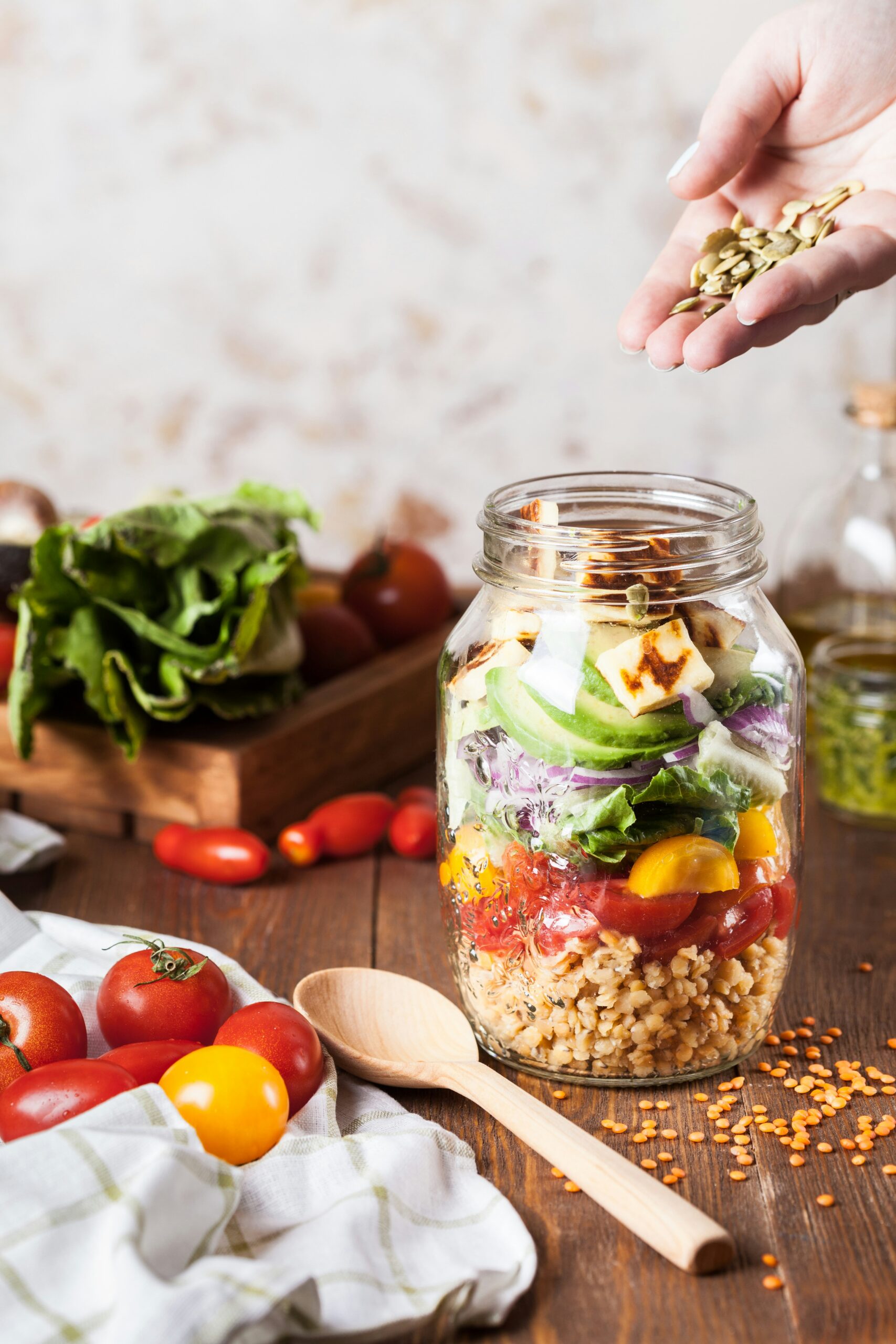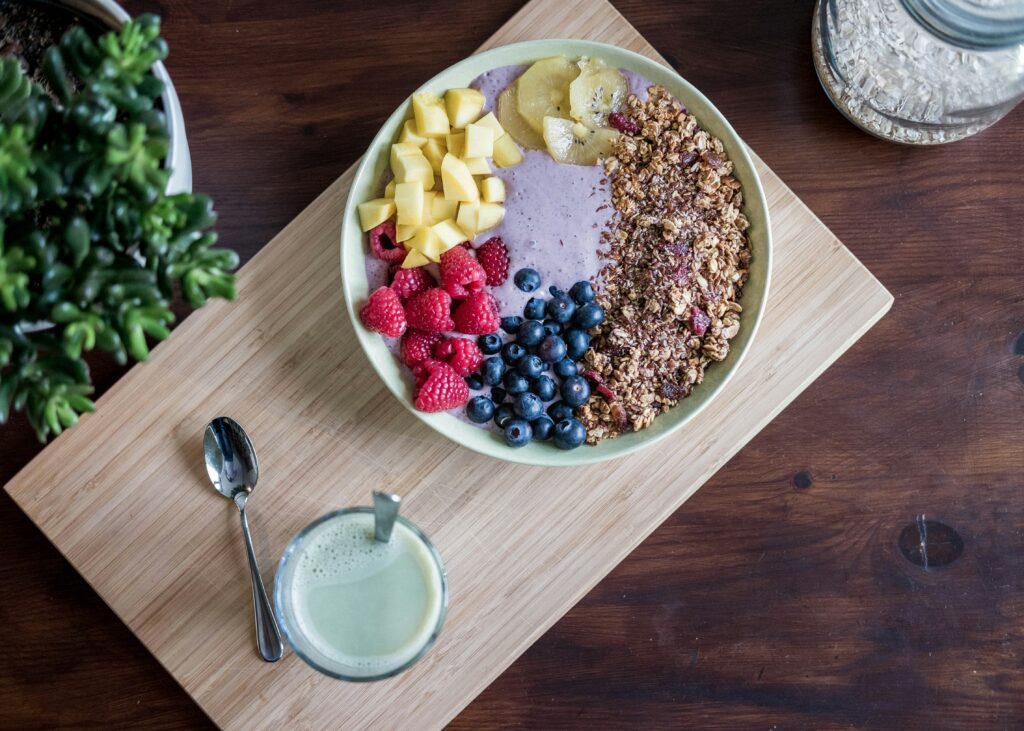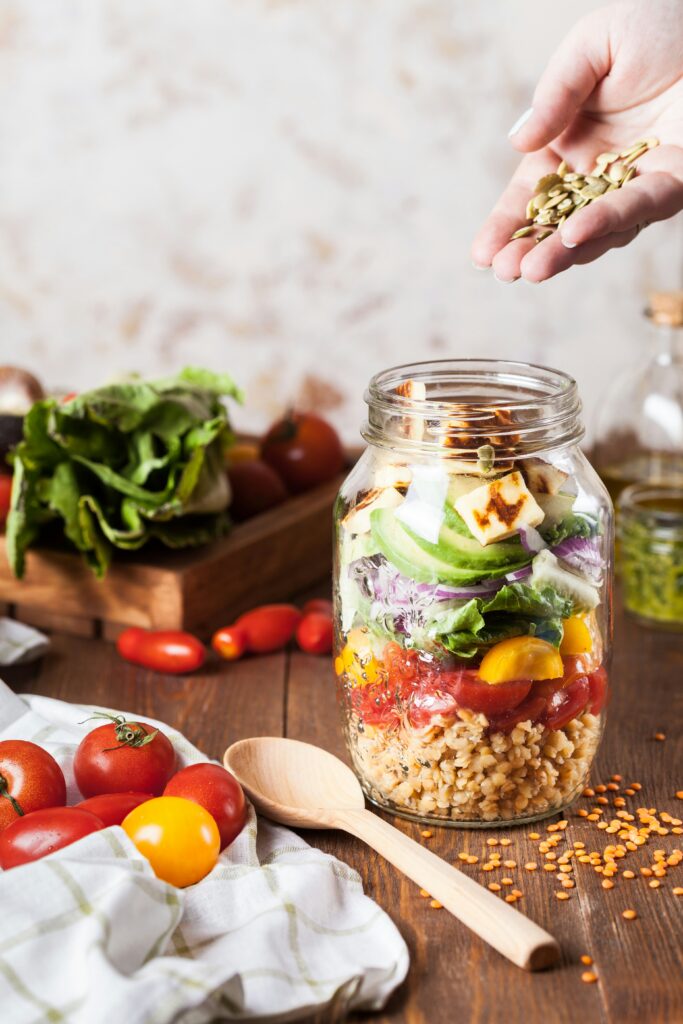Your cart is currently empty!

How to Eat Healthy on a Budget

Eating healthy can feel expensive—especially when grocery prices keep rising and ultra-processed foods often seem like the cheaper option. But the truth is, you don’t have to spend a fortune to eat well. With the right approach, you can build nutritious, satisfying meals without stretching your budget.
The key is knowing what to buy, how to plan your meals, and making the most of affordable, nutrient-dense foods. By focusing on whole ingredients, batch cooking, and smart grocery shopping strategies, you can enjoy balanced meals while saving money.
In this guide, we’ll cover practical, budget-friendly tips for grocery shopping, meal prepping, and cooking, plus healthy meal ideas that cost just a few dollars per serving. Let’s make eating well affordable and sustainable!
The Truth About Healthy Eating on a Budget
One of the biggest myths about healthy eating is that it’s expensive. Many people assume that eating well means buying organic produce, high-end superfoods, or expensive meal prep services, but that’s simply not true.
The reality? Healthy eating can be budget-friendly if you focus on the right foods and strategies. Whole, nutrient-dense ingredients like rice, beans, oats, eggs, frozen vegetables, and canned fish are not only affordable but also versatile and packed with nutrition.
Here’s what you need to know about making healthy eating affordable:
1. Processed Foods Aren’t Always Cheaper
- A $5 fast-food meal may seem cheap, but a home-cooked meal with whole ingredients can cost even less per serving.
- Ultra-processed foods tend to be low in nutrients and don’t keep you full for long, leading to more frequent snacking and spending.
2. The Right Staples Can Stretch Your Budget
- Foods like brown rice, beans, lentils, canned tuna, eggs, and frozen vegetables are nutritious, affordable, and long-lasting.
- Buying these staples in bulk can save money and reduce grocery trips.
3. Meal Planning and Prep Can Cut Costs
- Planning meals in advance helps reduce impulse purchases and food waste.
- Cooking in batches allows you to stretch ingredients across multiple meals, making your groceries last longer.
4. Eating Healthy Doesn’t Require Organic Everything
- While organic produce has benefits, non-organic fruits and vegetables are still incredibly nutritious.
- Prioritize affordable produce options—frozen and canned vegetables (with no added salt) are just as nutritious as fresh.
The key takeaway? You don’t need an unlimited grocery budget to eat well. By shopping strategically and using affordable, nutrient-dense staples, you can enjoy healthy, home-cooked meals without overspending.

Budget-Friendly Grocery Shopping Tips
Eating healthy on a budget starts at the grocery store. With smart shopping habits, you can buy nutritious foods without overspending. Here’s how to stretch your grocery budget while still prioritizing health:
1. Plan Your Meals in Advance
- Having a weekly meal plan helps you stick to your budget and avoid impulse purchases.
- Choose simple meals that use overlapping ingredients to minimize waste.
- Example: Buying a bag of spinach for salads can also be used in smoothies, omelets, or pasta dishes.
Pro Tip: Make a grocery list and stick to it. Shopping without a list often leads to unplanned spending on processed or convenience foods.
2. Buy in Bulk Whenever Possible
- Foods like rice, oats, beans, lentils, nuts, and frozen veggies are often cheaper per serving when bought in larger quantities.
- Consider bulk stores or wholesale clubs for pantry staples that last a long time.
- If buying in bulk isn’t an option, split a large purchase with family or friends to save money.
3. Prioritize Affordable Protein Sources
- Meat is often the most expensive part of a grocery bill, but there are plenty of budget-friendly protein options:
- Eggs – Inexpensive and packed with nutrients.
- Beans & lentils – High in fiber and protein, making meals more filling.
- Canned tuna & sardines – Affordable, long-lasting, and full of omega-3s.
- Tofu & tempeh – Great plant-based protein options.
- Chicken thighs & drumsticks – Cheaper than chicken breast but just as nutritious.
4. Shop Seasonal and Frozen Produce
- Fresh produce is cheaper when it’s in season, so adjust your meals to include seasonal fruits and vegetables.
- Frozen fruits and veggies are just as nutritious as fresh, last longer, and cost less per serving.
- Canned veggies (low-sodium) and canned fruits (in water, not syrup) are also good options when fresh produce is too expensive.
5. Skip Pre-Packaged and Convenience Foods
- Pre-cut fruits, individually packaged snacks, and frozen dinners cost more per serving than making your own.
- Example: A bag of pre-cut carrots costs twice as much as a whole bag of carrots you can chop yourself.
- Instead of buying pre-made granola bars or trail mix, make your own at home with oats, nuts, and dried fruit.
6. Stick to Store Brands
- Store-brand items are often identical to name brands but cost 20-30% less.
- Items like oats, canned beans, pasta, and frozen vegetables are great places to swap for store-brand versions.
7. Use Coupons, Loyalty Programs, and Discount Apps
- Many grocery stores offer loyalty programs that give discounts on essentials.
- Apps like Ibotta, Flipp, and Rakuten can help find sales and cashback deals.
- Buying discounted “ugly” produce (like from Imperfect Foods) can save money while reducing food waste.
8. Shop Smart for Dairy Alternatives
- If you buy almond, oat, or soy milk, check the price per ounce—some brands charge premium prices for trendy products.
- Instead of pre-flavored yogurt, buy plain yogurt and add fruit or honey at home for a cheaper, healthier option.
9. Avoid Grocery Shopping When Hungry
- Shopping on an empty stomach leads to impulse purchases and overspending on snacks.
- Eat a small meal or snack before going to the store to help stick to your grocery list.
10. Shop Discount or International Grocery Stores
- Stores like Aldi, Trader Joe’s, and local ethnic markets often have cheaper produce, grains, and spices than big chain supermarkets.
- International grocery stores are great for rice, beans, spices, and specialty ingredients at a fraction of the price.
Eating healthy doesn’t mean spending more. It means shopping smarter. By planning meals, buying in bulk, choosing affordable proteins, and focusing on whole foods, you can eat well while staying within your budget.
Next, let’s go over Smart Cooking Strategies to Stretch Your Budget so you can make the most of the groceries you buy!
Smart Cooking Strategies to Stretch Your Budget
Buying budget-friendly ingredients is only half the battle—how you cook and store your food plays a big role in making your groceries last longer and reducing waste. These smart cooking strategies will help you get the most out of every meal while keeping costs low.
1. Cook in Batches and Freeze Leftovers
- Cooking large portions at once saves time, money, and energy.
- Make big batches of soups, stews, casseroles, and grain bowls, then freeze portions for later.
- Store meals in airtight containers or freezer bags to keep them fresh.
Example:
- Cook a large pot of chili with beans, lentils, and ground turkey. Eat some now and freeze the rest for future meals.
- Make overnight oats in bulk—a cheap, easy breakfast that lasts all week.
2. Use One Ingredient Multiple Ways
Choose versatile ingredients that can be used in multiple meals to avoid waste.
Example:
- A bag of spinach → Use in salads, omelets, smoothies, and pasta dishes.
- A whole roasted chicken → Eat as a main meal, use leftovers for sandwiches, and make soup with the bones.
- Rice or quinoa → Serve as a side dish, mix into stir-fries, or add to soups for extra bulk.
3. Stretch Meat with Plant-Based Proteins
Meat can be expensive, but mixing it with plant-based proteins makes it last longer without sacrificing flavor.
Budget-friendly meat-stretching ideas:
- Add lentils or beans to ground beef/turkey when making tacos, chili, or pasta sauce.
- Use chickpeas or black beans in wraps, salads, and stir-fries for added protein.
- Make half-meat, half-veggie burgers by mixing ground beef with grated zucchini or mushrooms.
4. Master the Art of Repurposing Leftovers
Turn last night’s dinner into something new so you don’t get bored and waste food.
Example:
- Leftover roasted vegetables? Blend them into a soup or add them to a grain bowl.
- Cooked chicken from dinner? Use it in wraps, salads, or quesadillas the next day.
- Rice from last night? Make fried rice with eggs and frozen veggies for a quick meal.
5. Make Your Own Snacks Instead of Buying Packaged Ones
- Pre-packaged snacks are convenient but overpriced.
- Making your own saves money and lets you control the ingredients.
DIY Snack Ideas:
- Homemade trail mix → Mix bulk nuts, seeds, and dried fruit.
- DIY granola bars → Made with oats, peanut butter, and honey.
- Hard-boiled eggs → A simple, high-protein snack that costs cents per serving.
6. Reduce Food Waste with Proper Storage
Storing food correctly helps keep it fresh longer and prevents spoilage.
Storage Tips:
- Keep herbs fresh → Store in a glass of water in the fridge like a bouquet.
- Revive wilted greens → Soak them in ice water for 10 minutes to bring them back to life.
- Freeze overripe bananas → Use them later for smoothies or baking.
- Use vegetable scraps → Save them in a freezer bag and make homemade broth.
7. Cook Once, Eat Twice (Or More!)
- Plan meals so that one recipe can be used in different ways throughout the week.
- This cuts down on meal prep time and reduces the need to buy extra ingredients.
Example:
- Big batch of roasted chicken → Serve with rice and veggies one night, then use leftovers for tacos, salads, or sandwiches the next day.
- Make a large pot of lentil soup → Eat fresh one day and freeze portions for later.
8. Use Simple, Affordable Seasonings to Add Flavor
- Instead of buying expensive sauces, learn to season food with basic spices and herbs.
- Some budget-friendly spices that can transform meals:
- Garlic powder, onion powder, paprika, cumin, black pepper, and Italian seasoning.
- Soy sauce, vinegar, and mustard add depth to simple dishes.
Smart cooking strategies help you stretch your grocery budget while keeping meals nutritious and flavorful. By cooking in batches, repurposing leftovers, and using versatile ingredients, you can save time, money, and effort—while still eating well.

Affordable, Healthy Meal Ideas
Smart cooking strategies help you stretch your grocery budget while keeping meals nutritious and flavorful. By cooking in batches, repurposing leftovers, and using versatile ingredients, you can save time, money, and effort—while still eating well.
Breakfast Ideas ($1 or Less Per Serving)
- Oatmeal with banana and peanut butter
- Scrambled eggs with whole-grain toast
- Greek yogurt with frozen berries and granola
Lunch & Dinner Ideas ($2 or Less Per Serving)
- Lentil soup with whole-grain bread
- Rice and beans with sautéed veggies
- Chickpea and vegetable stir-fry over brown rice
- Baked sweet potatoes with black beans and avocado
- Homemade vegetable soup with whole-wheat pasta
Snack Ideas ($1 or Less Per Serving)
- Hard-boiled eggs
- Hummus and carrots
- Apple slices with peanut butter
- Homemade trail mix with nuts and dried fruit
Eating healthy on a budget isn’t about spending more—it’s about spending smarter. With a little planning, you can enjoy nutritious, satisfying meals without overspending.
By focusing on affordable staples like beans, lentils, oats, eggs, frozen vegetables, and whole grains, you can build balanced meals that keep you full and energized. Shopping strategically, cooking in batches, and reducing food waste can also help stretch your grocery budget further.
The key is making small, intentional choices—whether it’s meal prepping for the week, swapping expensive snacks for homemade options, or buying in bulk. Eating well doesn’t have to be complicated or expensive—it just takes a little creativity and planning.
If you’re looking for affordable, healthy meal ideas, start with one or two recipes from this guide and see how much you can save. Healthy eating is possible on any budget—you just need the right approach!
What’s your favorite budget-friendly meal? Share in the comments!

Leave a Reply